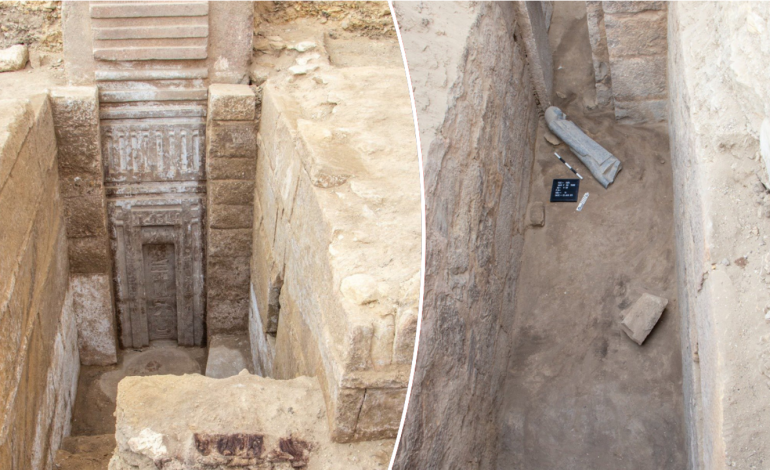Archaeologists excavating the ancient burial grounds of Saqqara have uncovered a remarkable tomb hidden behind a massive granite “false door” — a rare find that has stunned Egyptologists and revealed new insights into royal lineage during the Fifth Dynasty of ancient Egypt, Fox News reports.
The Egyptian Ministry of Tourism and Antiquities announced the discovery in a statement released on Facebook in April. The tomb, uncovered at the Saqqara archaeological site in the Giza Governorate, belonged to a prince named Userefre, also rendered as Waser Ef Ra, the son of Pharaoh Userkaf — the founding king of Egypt’s Fifth Dynasty, which reigned from approximately 2494 to 2345 B.C.
The tomb had been concealed by an unusually large pink granite false door, a symbolic architectural feature in ancient Egyptian tombs. The monolithic door stands nearly 14 feet high and over 3.7 feet wide, making it the first of its kind discovered at Saqqara, according to Egyptian officials.
Hieroglyphic inscriptions etched into the door identify the tomb’s occupant and enumerate his noble titles: “hereditary prince, regional governor of Buto and Nekheb, royal scribe, minister, judge, and chanting priest.”
Inside the tomb, archaeologists unearthed an array of significant artifacts and statues, including representations of King Djoser, his queen, and their 10 daughters. A red granite offering table inscribed with a list of funerary provisions was also found, alongside a large black granite statue and an additional pink granite tomb entrance.
One of the most notable findings was a unique arrangement of 13 pink granite statues seated on a high-backed bench, an architectural formation never before seen in the Saqqara region. Among these statues were several depicting the prince’s wives, as well as two headless figures and an overturned black granite statue.
The find follows a series of groundbreaking archaeological announcements in Egypt this year. In March, researchers revealed the unearthing of a 3,000-year-old mining complex, complete with remnants of ancient homes, workshops, and public baths. Separately, a University of Pennsylvania archaeologist recently located the long-lost tomb of a previously unknown Egyptian pharaoh — another extraordinary achievement in the ongoing exploration of Egypt’s ancient past.
Saqqara, home to Egypt’s oldest step pyramid and a necropolis used for more than 3,000 years, continues to be a treasure trove for discoveries illuminating the grandeur and complexity of ancient Egyptian society.










The latest news in your social feeds
Subscribe to our social media platforms to stay tuned